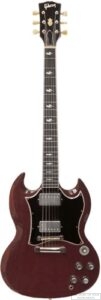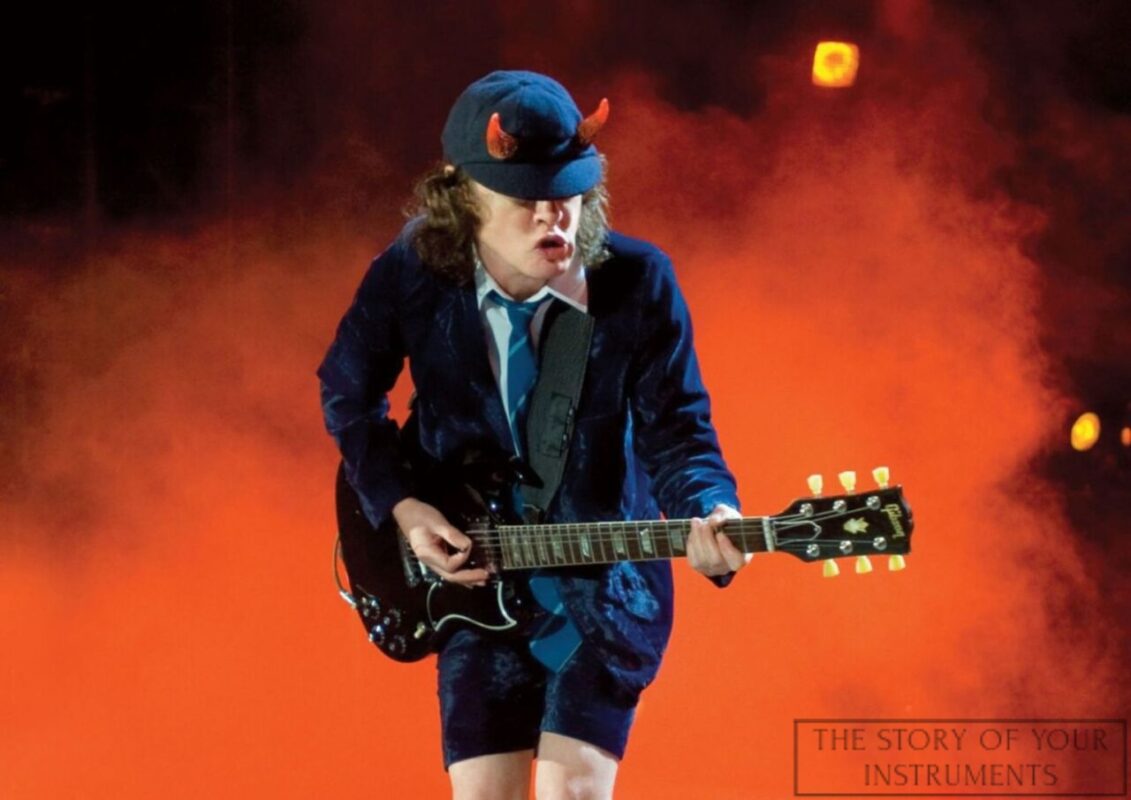
Angus Young is one of those guitarists who has been “attached” to one guitar for his entire career. In Young’s case, his guitar of choice is the Gibson SG, which he has used virtually since the beginning. His first guitar was a 1970 or 1971 Gibson SG Standard, finished in walnut and fitted with a Lyre Maestro tremolo bridge. He used this guitar exclusively on early albums and mainly only in the studio.
As soon as his SG began to see fewer lights on stage, more and more SGs alternated in his setup. In earlier years, there was a modified 1970s Gibson SG Custom, most famously used at the Hammersmith Odeon concert in 1979. In 1981, Angus also used a custom-made SG made by Jaydee, with custom-designed pickups and lightning bolt inlays.
For the rest of the 1980s and 1990s, and in more recent years, Angus continued to use various Gibson SG models. Some of them were models from the early 1960s, some were those from the 1970s with larger pickguards, and some were from Angus ‘ signature line produced by Gibson.
As for amplifiers, Angus is best known for using Marshall Model 1959 Super Lead, although he occasionally used several Marshall models as well as those of other brands. Notably, both he and Malcolm used Wizard amplifiers from the mid to late 1990s.
Gibson SG Standard 1970/71 by Angus Young
 This was Angus‘s first SG. He bought it when he was about 16 years old, around 1971, at a music store down the street from the family home in Sydney. He used this guitar exclusively for the first few years, until about 1978.
This was Angus‘s first SG. He bought it when he was about 16 years old, around 1971, at a music store down the street from the family home in Sydney. He used this guitar exclusively for the first few years, until about 1978.
This guitar was used extensively during AC/DC’s 1975 Australian “High Voltage” tour. At this point, it appears that Angus has removed the chrome pickup covers, both of which were present on the guitar in the photos taken in 1974.
However, according to a Guitar World article, the pickups were actually replaced at some point with a set of brand new Gibson humbuckers. This might explain the absence of the pickup covers, but the article seems to suggest that the switch was made earlier.
In 1976, and with the European“High Voltage” tour, things get a little confusing. Because almost all photographs taken during that period are in black and white and usually show a reduced amount of detail, it is impossible to state with certainty whether Angus is using this SG, or perhaps another model.
However, it seems that the guitar was used quite a bit at least until July 1976. At that point, it is possible that it was replaced at least temporarily with another red-colored SG.
Angus Young’s 1970s Gibson SG Standard (Second)
 In 1978, Angus purchased some Gibson SGs in one of the music stores on 48th Street in New York City.
In 1978, Angus purchased some Gibson SGs in one of the music stores on 48th Street in New York City.
This guitar was very similar in appearance to Angus ‘ first SG , which he used exclusively up to that time, and around 1974. The main difference between the two is that the new SG had a red finish, while the old one was finished in walnut (brownish color).
This appeared to have been Angus ‘ lead guitar during the Highway to Hell tour in 1979, and was also used to record the album.
For live performances, the guitar was used together with at least two other SGs. One was black with a large white “bat” pickguard, while the other was a red SG from the 1960s with a small pickguard. Based on the frequency of use, it seemed that the Gibson SG of the 1970s was the most widely used.
Angus Young’s 1970 Gibson SG Custom
This guitar was first used by Angus during the 1980 Back in Black tour . According to its current guitar technician, Trace Foster, originally, the SG was finished in walnut, featured three pickups and had a tremolo.
current guitar technician, Trace Foster, originally, the SG was finished in walnut, featured three pickups and had a tremolo.
Between 1980 and 2016, the guitar completely changed its appearance. Angus removed the center pickup and tremolo and painted the guitar black.
Now, at this point, it is important to remember that there was another Gibson black SG Custom at that time that looked similar to this guitar. That guitar was basically exactly the same as the guitar in the 2016 Premier Guitar interview. This has led to some confusion and people think it is the same….
To debunk this, just look for photos of the other black SG Custom (for example, look for photos of the 1979 Hammersmith Odeon concert). Since many of them date back to 1979, and this particular Custom was seen in its original state in 1980 (walnut finish, three pickups).
The only known photo of this guitar in its original state was taken by Ross Halfin, who says it was taken at the Hammersmith Odeon, but in 1980.
Gibson SG by Angus Young (walnut, lightning inlays)
 This guitar, according to John Diggins, was modified by him at some point in the early 1980s. In particular, John replaced the entire neck and inlaid the fingerboard with lightning-fast inlays. Originally, of course, the guitar had the regular block inlays Gibson.
This guitar, according to John Diggins, was modified by him at some point in the early 1980s. In particular, John replaced the entire neck and inlaid the fingerboard with lightning-fast inlays. Originally, of course, the guitar had the regular block inlays Gibson.
Guitar before modifications
The confusing thing about this guitar is that although based on John’s statement, it was used extensively by Angus (sweat, wear and tear), and it is very difficult to find photos of the guitar before the modifications.
This raises the question of what Angus‘s original 1970s walnut SG might be. However, both guitars had tremolos, and this would have left the empty screw holes exposed when removed. This SG, modified by Diggins, had no such holes.
2000 and beyond
This guitar returned to prominence with the 2000 Stuff Upper Lip tour , during which Angus used it extensively. Based on the photos, the guitar was used together with other SGs.
It was used again during the Black Ice tour around 2010, which means it was probably among Angus‘s favorites, at least based on the frequency of use over the years.
Angus Young’s 1960s Gibson SG Standard (black, Donington)
This guitar was Angus ‘ main guitar during the Razors Edge (1990) and Ballbreaker (1995) tours, at least in based on how often it was used. In particular, Angus used it on August 17, 1991, for the Live at Donington concert aka Monsters of Rock, and on July 10, 1996, during No Bull.
based on how often it was used. In particular, Angus used it on August 17, 1991, for the Live at Donington concert aka Monsters of Rock, and on July 10, 1996, during No Bull.
Although it is not known for certain that this is the exact same guitar (Donington and No Bull), based on the photos, it appears to be. Both have the same finish and specifications, and both have Les Paul truss rods, which means this is probably an early to mid-1960s model.
As noted earlier, based on the truss rod cover (since it is original), this is an early to mid-1960s SG Standard. The finish is black, which cannot be original since this was not an option on the early 1960s models. This opens up the possibility that it is one of Angus‘s older guitars, one that he perhaps likes more than the others, which is why he decided to restore it for the Razor’s Edge tour .
Another thing worth noting is that the guitar had Grover tuners instead of the original Kluson tuners with plastic buttons.
Starting from the fact that the guitar was used during both the Razor’s Edge and Ballbreaker tours, it is likely that Angus also used it in the studio.
Angus Young’s 1960s Gibson SG Standard (Black Ice, Rock or Bust)
 This guitar was seen occasionally during the Stiff Upper Lip live tour (2000), and more often during the Black Ice (2008-10) and Rock or Bust (2016) tours. It looks similar to the Gibson SG used by Angus in the 1990s.
This guitar was seen occasionally during the Stiff Upper Lip live tour (2000), and more often during the Black Ice (2008-10) and Rock or Bust (2016) tours. It looks similar to the Gibson SG used by Angus in the 1990s.
This SG is finished in black, which was most likely a finish. Fill Olivieri at SoloDallas also suspects that this is a mid-1960s model with the Vibrola tremolo removed, which also has a somewhat wider “neck” than the early 1960s model.
The guitar technician of Angus, Trace Foster pretty much confirmed this in the 2016 Rig Rundown interview with Premier Guitar. According to him, the guitar is a 1967 model, with Seymour Duncan pickups, both waxed and all new Gibson electronics. [ Rig Rundown – Angus Young and Stevie Young of AC / DC ]
However, as Brian pointed out in the comments, based on the location of the crown inlay on the headstock, this is probably an earlier model. On models made after the end of 1966, the crown was moved downward, so Angus ‘s guitar must have been a 1966 or 1965 model, although it is possible that this change occurred in early 1967 (sources vary depending on the exact year). It is also possible that some necks remained from 1966 and were assembled on guitars made in 1967.



Stay connected